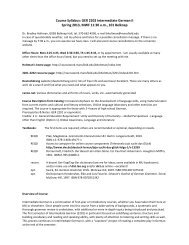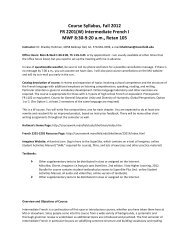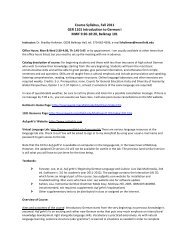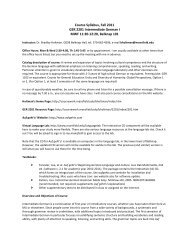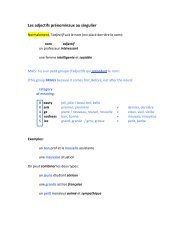Internal Alignment
Internal Alignment
Internal Alignment
You also want an ePaper? Increase the reach of your titles
YUMPU automatically turns print PDFs into web optimized ePapers that Google loves.
<strong>Internal</strong> <strong>Alignment</strong>
STRATEGICPOLICIESTECHNIQUESSTRATEGICOBJECTIVESALIGNMENTCOMPETITIVENESSCONTRIBUTORSWork Descriptions Evaluation/ INTERNALAnalysisCertification STRUCTUREMarket Surveys Policy PAYDefinitions Lines STRUCTURESeniority Performance Merit INCENTIVEBased Based Guidelines PROGRAMSEFFICIENCY Performance Quality CustomersStockholders CostsADMINISTRATIONPlanning Budgeting Communication EVALUATIONFAIRNESSCOMPLIANCE(Milkovich, Newman, & Gerhart, 2011)
<strong>Internal</strong> alignment, often calledinternal equity, refers to the payrelationships among differentjobs/skills/competencies within asingle organization.(Milkovich, Newman, & Gerhart, 2011, p. 69)
Consequences of an <strong>Internal</strong>ly Aligned StructureUndertake trainingIncrease experiencePay structureReduce turnoverFacilitate career progressionFacilitate performanceReduce pay-relatedgrievancesReduce pay-related workstoppages(Milkovich, Newman, & Gerhart, 2011, p. 86)
Pay structure refers to the array ofpay rates for different work or skillswithin a single organization.The number of levels, thedifferentials in pay between thelevels, and the criteria used todetermine those differences describethe structure.(Milkovich, Newman, & Gerhart, 2011, p. 69)
Levels• Pay structure is often hierarchical, based on:– Number of levels– Reporting relationships(Milkovich, Newman, & Gerhart, 2011)
Differentials• The pay differences between levels• Pay is determined by:– Knowledge/ skills involved– Working conditions– Valued addition to the company• Intention of these differentials:– To motivate people to strive for promotion to ahigher-paying level(Milkovich, Newman, & Gerhart, 2011)
Pay Structure180160140120100806040200Compensation(in thousands of $)EngineerSeniorEngineerSystemsEngineerLead EngineerAdvisorEngineerConsultantEngineer(Milkovich & Newman, 2008)
Guidance from the Evidence• Equity theory: Fairness– Research suggests that employees judge fairnessby multiple comparisons• Comparing to jobs similar to their own at same employer• Comparing their job to other jobs at same employer• Comparing their jobs’ pay against external pay levels• Comparing their pay for similar work at different timeperiods(Milkovich, Newman, & Gerhart, 2011)
Equity Theory – Adams (1965)“Person”“Inputs”“Outcomes”compared to“Comparison Other”“Inputs”“Outcomes”A “social comparison” theory of motivation. Person compares his or herratio of Inputs to Outcomes with the Inputs to Outcomes ratio for aComparison Other. Ratios that are not “in balance” are perceived asinequitable and may trigger actions to redress the imbalance(Muchinsky, 2003)
(Milkovich & Newman, 2008)Perceived Equity of a Pay StructureMY PAYMy qualificationsMy work performedMy product valueOTHERS’ PAYTheir qualificationsTheir work performedTheir product value
Guidance from the Evidence (cont.)• Tournament theory: Motivation andperformance– All players will play better in first tournament,where prize differentials are larger– Greater difference between an employee’ssalary and the boss’s, harder he/she will work– Several studies have given rise to “winnertakes-all”– Does not directly address turnover(Milkovich, Newman, & Gerhart, 2011)
(More) Guidance from the Evidence Impact of internal structures depends onCONTEXT in which they operate More hierarchical structures are related togreater performance when the work flowdepends on individual contributors High performers quit less under morehierarchical systems when:• Pay is based on performance rather thanseniority• When people have knowledge of the structure(Milkovich, Newman, & Gerhart, 2011)
(More) Guidance from the Evidence (cont.)• When close collaboration and sharing ofknowledge are required, more egalitarianstructures are related to greaterperformance(Milkovich, Newman, & Gerhart, 2011)



